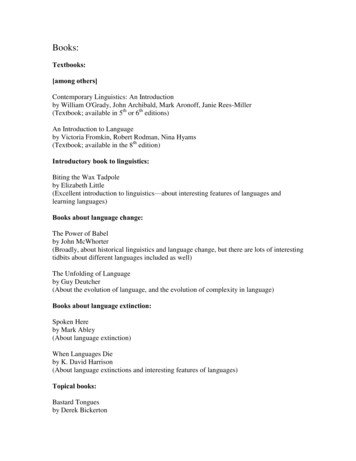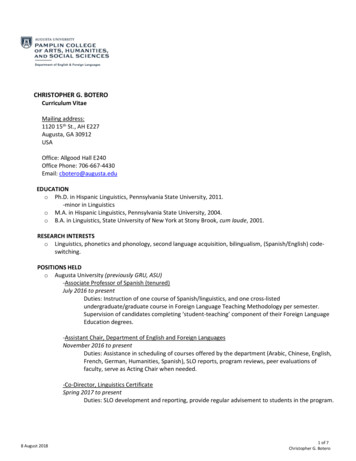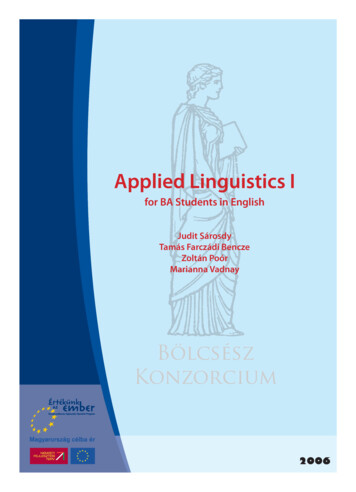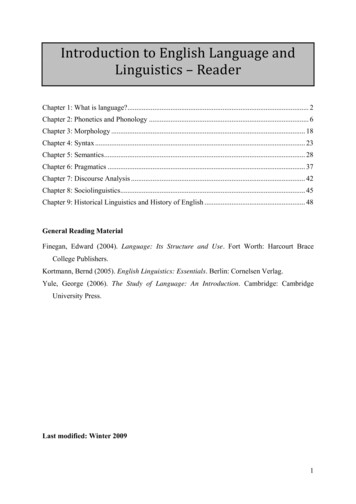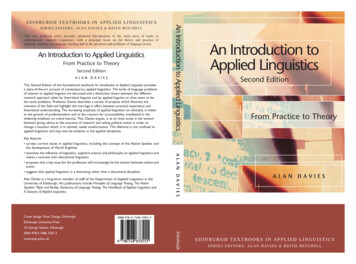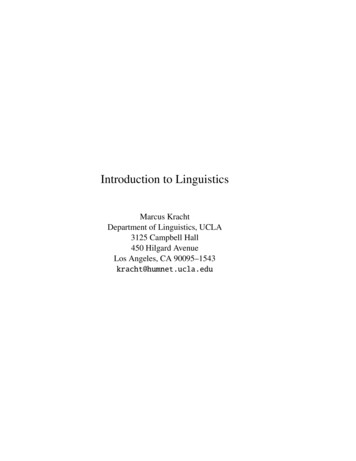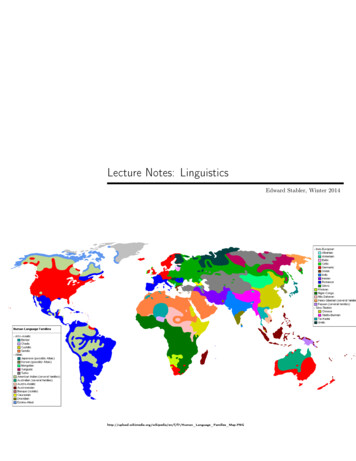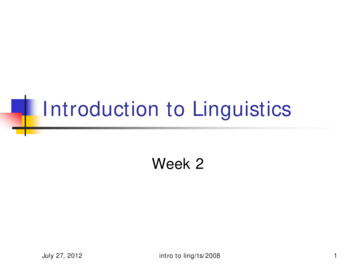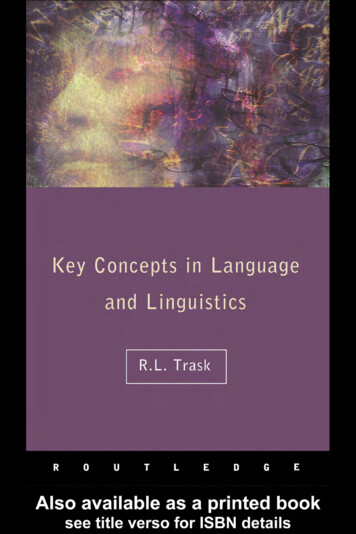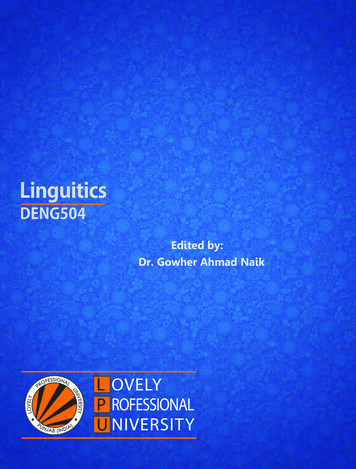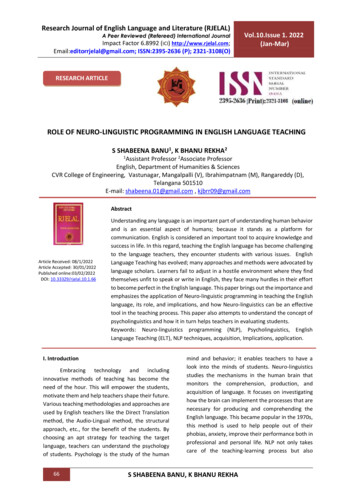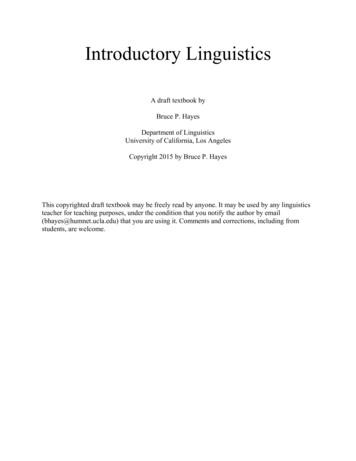
Transcription
Introductory LinguisticsA draft textbook byBruce P. HayesDepartment of LinguisticsUniversity of California, Los AngelesCopyright 2015 by Bruce P. HayesThis copyrighted draft textbook may be freely read by anyone. It may be used by any linguisticsteacher for teaching purposes, under the condition that you notify the author by email(bhayes@humnet.ucla.edu) that you are using it. Comments and corrections, including fromstudents, are welcome.
HayesIntroductory Linguisticsp. 2ContentsPrefaceChapter 1:What is Linguistics?Chapter 2:MorphologyChapter 3:Normative views of languageChapter 4:Syntax I — Phrase StructureChapter 5:Syntax II — TransformationsChapter 6:Syntax III — Subcategorization and Wh- MovementChapter 7:Language AcquisitionChapter 8:Review of Morphology and SyntaxChapter 9:SemanticsChapter 10: PhoneticsChapter 11: Phonology I — Phonemic AnalysisChapter 12: Phonology II — Optional Rules, Phonology/Morphology InteractionChapter 13: Historical LinguisticsChapter 14: Applications and OutlookChapter 15: More review problemsp. 3p. 4p. 18p. 60p. 69p. 144p. 158p. 241p. 251p. 295p. 355p. 394p. 427p. 455p. 512p. 520
HayesIntroductory Linguisticsp. 3PrefaceThis text has been written by me, gradually over the years, for the course “Linguistics 20:Introduction to Linguistic Analysis”, which I teach in my home department at UCLA. The courseis meant to be a short introduction to “core” linguistics, by which I mean the analysis of languagedata using theory. (My department covers broader issues, such as language in society, in aseparate course, “Introduction to Language”.) To the extent that my text is successful, studentswill get a clear idea of the goals and character of linguistic analysis and will be well prepared totake on the various subfields of linguistics in later specialized courses.My text follows mainstream thinking in linguistics in assuming that learning the field is bestdone through exercises in which students deal with language data, trying to nail down the patternand express it clearly with rules. The course I teach includes weekly homeworks of this kind;these homeworks include the most ambitious problems. In this text there also 90 StudyExercises; some are interspersed at appropriate moments in the presentation; others are placed inChapters 8 and 15, meant for pre-midterm and pre-final review. I have arranged the page breaksto make it convenient for students to try to solve the exercises themselves before consulting theprinted answer.The main purpose of the exercises is to help students make the essential transition frompassive knowledge (material makes perfect sense when the professor or text explains it) to activeknowledge (student can apply the theory in new contexts and make independent assessments). Intruth, I also hope that the exercises will be not just a way of achieving control over the materialbut at least occasionally a source of intellectual pleasure. Most linguists I know enjoy the puzzlespresented by language data and I hope that for the reader it will be the same.My thanks go to the many students who have read through earlier versions of this text, oftenusefully pointing out errors. I also thank my many teaching assistants for their wisdom and firsthand experience, along with my colleagues Sandra Disner, Craig Melchert, and Jessica Rett forexpert advice.
HayesIntroductory Linguisticsp. 4Chapter 1: What is Linguistics?1. What this book will be likeLinguistics is the science of language; it studies the structure of human languages and aimsto develop a general theory of how languages work. The field is surprisingly technical; todescribe languages in detail requires a fair amount of formal notation. A good parallel would bethe field of symbolic logic, which uses a formal notation to understand the processes ofreasoning and argumentation.There are basically three things I hope you will get out of this book.First, there is the subject matter itself, which is useful to know for people in many differentfields, such as education, psychology, and computation. The course is also an introduction tolinguistics for those who are going to major in it.Second, the course involves some mental exercise, involving analysis of data from Englishand other languages. I doubt that anyone who doesn’t go on in linguistics will remember much ofthe course material five years after they have graduated, but the analytical skills in which youwill get practice will be (I hope) both more permanent and more useful.Third, the course is intended to give a more realistic view of science and how it proceeds.The reason we can do this in linguistics is that it is a fairly primitive science, without anenormous body of well-established results. Because of this, we are less interested in teaching youa body of established knowledge; rather, our focus is on teaching you to decide what is right onyour own, by looking at the data. All sciences are in this state of uncertainty at their frontiers;linguistics can give you a more authentically scientific experience in a beginning course.2. Implicit and explicit knowledge of language; working with consultantsLinguists are constantly asked the question “How many languages do you speak?” Thisquestion is a little irritating, because it is largely irrelevant to what linguists are trying to do. Thegoals of linguistics are to describe and understand the structure of human languages; to discoverthe ways in which all languages are alike and the ways in which they may differ. The point isthat even if one could speak all 8000 or so of the world’s languages, one would not have solvedany of the problems of linguistics.The reason is this: speaking a language and knowing its structure are different things. Inspeaking a language, one uses thousands of grammatical rules without being aware of them; theyare “unconscious knowledge.” Linguists attempt to make explicit this unconscious knowledge bylooking closely at the data of language. That is, they attempt to make the “implicit knowledge”of native speakers into explicit knowledge.This goal implies one of the central methods of doing linguistic research, the consultantsession. Quite often, a linguist will study the structure of language she does not speak; this is
HayesIntroductory Linguisticsp. 5done by finding a native-speaker consultant to provide the data. The linguist normally asks theconsultant a great number of questions. Some of them are simple and establish basic knowledge:(1) “What is the word for “duck” in your language?”Others look for the various different grammatical forms of the same word:(2) “How would you say “two ducks”?(This would be looking, perhaps, for how plurals are formed). Others involve whole sentencesand often their meanings as well.The crucial idea in a consultant session is that the linguist is thinking about structure—ismaking and checking hypotheses. The native speaker is most often trying simply to provide anhonest and accurate report of how she speaks the language, and of her intuitions about meaningand other matters.Obviously, the lines can be blurred a bit: sometimes the consultant (especially if she knowssome linguistics), may want to suggest some hypotheses herself. And linguists sometimes “workon themselves,” so that the dialogue across the consultant table becomes an internal dialogue inthe mind of the linguist.1The following example illustrates the method: for one particular area of English grammar,we get some native speaker intuitions, and work out a series of hypotheses for what the rules ofEnglish are. We’ll assume without comment that we are working with a native speaker ofEnglish, and indeed, I believe that the data below are characteristic of intuitions of English nativespeakers.The point of the analysis will be to illustrate a consistent truth about linguistics: the nativespeaker consultant doesn’t know the answer. You cannot effectively ask the consultant toprovide the linguistic analysis. However, the native speaker does have the tacit, intuitiveknowledge that makes it possible to find the answer, or at least to get closer to it.3. The reference of each otherIn the sentence (3), a native speaker of English is likely to tell you that each other refers towe, and that it means something like, “I like you and you like me.”(3) We like each other.(4) Alice and Sue like each other.In linguistics this is often called the reciprocal reading; i.e. it says we are in a state of reciprocalliking. Sentence (4) has a similar reciprocal reading.1In practice I and probably other linguists find this hard to do; it’s just too much going on in yourhead at once. More important, it poses methodological problems; the data are likely to be contaminated bywishful thinking.
HayesIntroductory Linguisticsp. 6Sentence (5) is a bizarre sentence, in that each other cannot logically refer to I.(5) *I like each other.The native speaker responds to it by saying, “That’s weird/that’s bizarre/you can’t say that inEnglish.” We will say for present purposes that (5) is ungrammatical; that is, ill-formed.Following standard practice, I will place an asterisk before sentences that are ungrammaticalIn (5), the ungrammaticality can be traced to the absence of any plausible interpretation forthe sentence; since each other describes reciprocal actions, like this:(6)XXYYEach other cannot be used unless the agent of the action is plural. But not all cases can beexplained in this way. In (7), you can think of a meaning that the sentence could in principlehave, but this meaning is not allowed by the rules of English grammar (think through what thismeaning would be, then check yourself by reading this footnote2):(7) *Alice and Sue think I like each other.In other words, being grammatical and having a sensible meaning are two different things.Sentence (7) shows the same thing: you can think up two logically possible meanings, butonly one meaning is allowed by the rules of English.(8) We believe they like each other.Again, reason it through for yourself then read the footnote.3We’ve now reached our basic point: there must be some rule of English that accounts forwhat each other can refer to, but it is a tacit rule. No one can look inside their mind to find outwhat the rule is; one can only look at the data and try to figure the rule out. Linguists haveworked on this particular rule for some time, and have gradually made progress in stating therule accurately. But we cannot claim to have a final answer.I will present a partial answer here. We will need two preliminary definitions, both of whichwill come up later on in the course. Here is the first one:23John thinks I like Bill and Bill thinks I like John.Possible meaning: if they refers, for instance to Bill and John, then We believe that Bill likes Johnand John likes Bill. Impossible meaning: I believe that John and Bill like you and you believe that Johnand Bill like me.
HayesIntroductory Linguisticsp. 7(9) Defn.: clauseA clause is either a whole sentence or a sentence within a sentenceYou can identify clauses because they generally have a subject and a verb, and they expresssome sort of proposition. We depict clauses by drawing brackets around them; labeled “S” for“sentence”.(10) [ We like each other. ]S(11) [ John and Bill like each other. ]S(12) *[ I like each other. ]S(13) *[ John and Bill think [I like each other. ]S]S(14) [ We believe [ they like each other. ]S]SNote that clauses can have clauses inside them. In (13), there is a clause that expresses thecontent of John and Bill’s thoughts (I like each other), and the whole thing is an (ungrammatical)clause that describes a state (John and Bill are having a particular thought.)We also need to define noun phrases.(15) Defn.: noun phraseA noun phrase is a complete syntactic unit that refers to a thing or a set of things.So, in (10), we is a noun phrase, and each other is a noun phrase. In (7), John and Bill is anoun phrase4 and again so is each other.With these definitions, we can write a tentative rule for what each other refers to:(16) Each other reference ruleEach other can refer only to noun phrases that are inside the smallest clause containing it.Like all proposed linguistic rules, this should be applied with great care, checking to see if itworks. We can make our work more careful with appropriate graphics, like underlining the nounphrases and putting brackets around the clauses. Let’s give it a try.Consider first (14), We believe they like each other. We want each other to refer only tothey, and not to we. We can underline and bracket in the appropriate way, and try drawing arrowsindicating candidates for the reference of each other, like this:4Also, as a matter of fact, John is a noun phrase, and Bill is a noun phrase; they are noun phrasesinside a bigger noun phrase. We will see quite a bit of this later on.
HayesIntroductory Linguisticsp. 8(17) [We believe [they like each other.]S]SokimpossibleSince the smallest clause containing each other is the smaller one, and it contains the nounphrase they, the theory predicts that each other should be able to refer to they and not to we. Thisseems to be correct; i.e. so far the theory is working.Considering next John and Bill think I like each other. I suggest at this point you jot downthe structure yourself (brackets, underlines, arrows), and check what you wrote against what yousee in (18) on the next page.
HayesIntroductory Linguisticsp. 9(18) *[John and Bill think [I like each other.]S]SimpossibleimpossibleWhy is this sentence ungrammatical? The reasoning here is more subtle. Each other cannotrefer to John and Bill because of the Each Other Reference Rule, which permits it only to refer tonoun phrases inside the smallest clause that contains it. But then why not let each other refer toI? Here, we run into the semantic restriction we saw earlier: each other can only refer to pluralnoun phrases. So no matter how you attempt to interpret each other, the sentence gets blocked,and in the end it is simply ungrammatical.Cases (10)-(12) are easy: there is only one noun phrase for each other to refer to, and therule permits this.3.1 Ambiguous sentences with each otherNotice that in a sentence with just one clause, but two noun phrases in addition to eachother, there will be two possibilities for what each other might refer to:(19)[We wrapped the ropes around each other.]SokokThis is just what the Each Other Reference Rule predicts. Because of this, the sentence has twopossible meanings. Try making up similar cases (a few are given in the footnote5).4. The role of implicit noun phrasesHere are some further relevant data, which are perhaps syntactically the most interesting:(20) [We consulted two detectives in order [ to find out about each other]S]S(21) [They seem to us [to like each other]S]SThese sentences are mysterious: it looks like there is no noun phrase at all that occurs insidethe smallest clause containing each other (other than each other itself). But consider the meaningof the sentences: someone is doing the finding out in (20), namely, “we”, and someone is doingthe liking in (21), namely “they”. Thus, the peculiar clauses to find out about each other and tolike each other appear to have implicit noun phrases. They have a meaning, but they’re notpronounced.5We assigned the representatives to each other. We instructed Fred and Sue on behalf of eachother. Alice and Sue introduced the students to each other’s mother. We prepared the cannibals for eachother.
HayesIntroductory Linguisticsp. 10For purposes of analyzing explicitly, let us fill them in, inserting overt noun phrases thatdesignate what the implicit noun phrases mean:(22) [We consulted two detectives in order [(we) to find out about each other]S]S(23) [They seem to us [(they) to like each other]S]SWith the implicit subjects filled in, we can explain what is going on. The Each OtherReference Rule needs slight revising:(24) Each Other Reference Rule (revised)Each other can refer only to noun phrases (including implicit noun phrases) that are insidethe smallest clause containing it.So now, to apply the Each Other Reference rule properly, we need to evaluate the referenceof implicit noun phrases. Here is an analytic diagram for sentence (20):(25) [We consulted two detectives in order [(we) to find out about each other]S]SokimpossibleWe will do more on this kind of rule later. The major gap in the analysis as given so far isthat we haven’t said anything about what causes the implicit noun phrase to take on a particularmeaning—for instance, why does the implicit noun phrase in (25) have to mean we, and not twodetectives? This would lead us into a different area of English grammar, covering the implicitnoun phrase behavior of the phrase in order to and many other grammatical constructions.The example also makes a general point about analytic practice in linguistics: linguists are,in general, willing to go out on a limb and propose structural analyses that include inaudibleentities like implicit noun phrases. Such analyses are always more controversial, since they reston inference rather than directly observable facts. But they can be supported, notably by referringto the meaning of sentences and to the overall coherence of the language system that they makepossible.4.1 Each other: the bottom lineI’ve gone into the example in a little bit of depth for two reasons. First, it should give you aflavor of linguistic analysis: we assume that utterances have structure, like clauses and nounphrases and implicit noun phrases. We also assume that the language has rules, like the EachOther Reference Rule. Much of the work of linguistics involves analysis, finding out thestructures and rules that do justice to the facts of a language.
HayesIntroductory Linguisticsp. 11The other main point so far concerns the question of unconscious knowledge. Any nativespeaker of English will have the intuitions about grammaticality and other matters that we, aslinguists, use to justify our analysis. Thus, knowing English means that you “know” the EachOther Reference Rule, in an intuitive, unconscious sense. But it does not mean that you know itexplicitly. There is no English speaker on earth who can just “look inside her head” and say whatthe rule is. The only way to make progress on language structure is the more indirect way laidout here: we make hypotheses about structure and about rules, then refine and improve them aswe encounter more language data. The procedure is actually much the same as in other sciences:we gather data (here, from the native speaker) and formulate hypotheses. The hypotheses makepredictions about what we will find in new data, which we can then gather. Sometimes the newdata makes our hypotheses look good, increasing our confidence; sometimes the new data isproblematic for our hypotheses, forcing us to modify them or even abandon them and trysomething else. With patience, we can achieve gradual progress; though we cannot directlyaccess the speaker’s unconscious knowledge of her language, our repeated inquiries can achievean ever better approximation of it.In the long run, we want a linguistics that has strong predictive capacity. For instance, weought to be able to make an accurate prediction about the intuitions of a native speakers about asentence before we ever elicit it. This is a hard goal and unlikely to be achieved very soon.5. The field of linguisticsWith this background, here is a (somewhat narrow) definition of the field of linguistics: it isthe study of the (largely implicit) knowledge people have when they speak a language. Some ofthe subfields of linguistics are the following:SyntaxSemanticsMorphologyPhonologystudy of rules for forming sentencesstudy of rules for meaningstudy of rules for forming wordsstudy of rules of pronunciationIn all cases, the “rules” are of the kind known implicitly by native speakers, not the kindlearned in school. Linguistics has two other major subfields that also involve rules but are not asdirectly focused on them: phonetics, which studies how sounds are produced and perceived, andhistorical linguistics, which studies how languages change and evolve.Linguists attempt to arrive at explicit knowledge of all the world’s languages. I should pointout that this task will never be completed. First, there are over 8000 different languages, many ofwhich are spoken in remote areas of the world.6 More important, the amount of explicitknowledge contained in just a single language would fill a whole library. Linguists find it bothfrustrating and astonishing that a small child can acquire implicitly in just a few years the sameknowledge that takes decades of hard work for linguists to figure out explicitly.6The best directory to the world’s languages is the Ethnologue, on line athttp://www.ethnologue.com/.
HayesIntroductory Linguisticsp. 12Linguists are also interested in developing a general theory of language; a theory of theproperties that all languages share. These are called linguistic universals. Finding universals isalso challenging; many linguists have the experience of having proposed a linguistic universal,only to find out later on about languages that don’t fit in.6. What’s this about “native speakers”?I mentioned native speakers at the start of this chapter and would like to fill in a bit ofinformation for why native speakers are considered important in linguistics.A native speaker, to give a very strict definition, is someone who has heard their languagecontinuously since birth, learned it in the natural way from exposure (as we say, “at his mother’sknee”; “at her father’s knee”), and continues to speak it regularly in everyday life, so they stay inpractice, as it were. You can be a native speaker of one language (like me), or sometimes of twoor more, or of none. The latter usually happens when someone switches languages in midchildhood.I wish to emphasize: there are no value judgments being made when linguists talk aboutnative speakers! We don’t think native speakers are better (or worse) than other people.However, like scientists everywhere, we like our data to be replicable: another scientist shouldbe able to conduct the same research and find out if the original results were correct. The nativespeaker idea is meant to assist replicability. Linguist #1 can say, “the results of this study comefrom four native speakers of Language X, all of whom speak the dialect characteristic of middleclass inhabitants of city Y.” Then, if Linguist #2 wants to carry out further study, or check #1’sresults, she can go to city Y, find middle-class native speakers, and advance the researchprogram further.The reason using native speakers as consultants makes this easier is that native speakers tendto be more uniform in their linguistic systems, have more confidence in the forms of theirspeech, and typically speak their language in its richest and most intricate form. Non-nativespeakers are more vulnerable to arbitrary, external factors. These include interference from theirnative language, or the accidents of what sort of data they encountered learning their nonnativelanguage.
HayesIntroductory Linguisticsp. 13Study Exercises for “each other”The first exercise is a very basic one: finding clauses and implicit subjects. This will matter a lotlater on. The others are more directly related to the each other phenomenon.Study Exercise #1This exercise simply asks you to find the clauses and the Noun Phrases. Put [ ]S bracketsaround the clauses and underline the Noun Phrases. Be sure to get all of them. If the subject isimplicit, put “( )” where the subject would be and say what it stands for.Examples:i.ii.Alice believes that Fred sang. Answer: [ Alice believes that [ Fred sang ]S ]SAlice hopes to climb Everest. Answer [ Alice hopes [ (Alice) to climb Everest ]S ]SExercises:a.b.c.d.e.f.g.h.i.j.I believe that turtles can swim.The fact that Fred left bothers Alice.Bill said that Jane sang and Fred danced.I persuaded Fred to buy a telescope.I promised Fred to buy a telescope.To appear on television is her fondest dream.Joe said that he wants to leave.That Jane can sing tenor makes no difference.Bill left because he was tired.the idea that truth is obtainable
HayesIntroductory Linguisticsp. 14Answer to Study Exercise #1a. [ I believe that [ turtles can swim. ]S ]Sb. [ The fact that [ Fred left ]S bothers Alice. ]SComment: the fact that Fred left is a Noun Phrase with a Noun Phrase inside it; hence doubleunderlines. We’ll come back to this; but let’s not worry about it for a while.c. [ Bill said that [ [ Jane sang ]S and [ Fred danced. ]S ]S ]SComment: Jane sang and Fred danced are two simple sentences; Jane sang and Fred dancedis a more complex sentence that expresses what Bill said; and the whole thing is a sentence.d.e.f.g.h.i.j.[ I persuaded Fred [ (Fred) to buy a telescope. ]S ]S[ I promised Fred [ (me) to buy a telescope. ]S ]S[[ (her) to appear on television ]S is her fondest dream. ]S[ Joe said that [ he wants [ (Joe) to leave. ]S ]S ]S[ That [ Jane can sing tenor ]S makes no difference. ]S[ Bill left because [ he was tired. ]S ]Sthe idea that [ truth is obtainable ]SComment: the whole thing is not a sentence; it’s a Noun Phrase; hence the doubleunderlining. When people speak, they use a mixture of sentences, noun phrases, interjections,and various other linguistic ��———————Study Exercise #2This sentence is ambiguous:My sister and I gave our parents books about each other.Explain each possible meaning and illustrate it with a diagram (brackets and arrows) like theones given above.
HayesIntroductory Linguisticsp. 15Answer to Study Exercise #2My sister and I gave our parents books about each other.One meaning: “My sister gave our parents books about me and I gave our parents booksabout my sister.”Other meaning: “My sister and I gave our mother a book about our father and gave ourfather a book about our mother.”Diagram:[ My sister and I gave our parents books about each other. ��—————Study Exercise #3This sentence is ambiguous:Bill and Fred persuaded Alice and Sue ( ) to buy telescopes in order ( ) to find out moreabout each other.For example, in one reading, you could continue: “In fact, as it turned out, Bill succeeded infinding out more about Fred, but Fred did not succeed in finding out more about Bill.” In theother reading, you could continue, “In fact, as it turned out, Alice succeeded in finding out moreabout Sue, but Sue did not succeed in finding out more about Alice.”For each meaning, fill in the implicit subjects shown with ( ). Then draw diagrams for thereference of each other. (So you’ll end up with two diagrams.)
HayesIntroductory Linguisticsp. 16Answer to Study Exercise #3:The impossible readings are the ones where each other refers to something outside thesmallest clause containing it.[Bill and Fred persuaded Alice and Sue [(Alice and Sue) to buy telescopes in order [(Bill and Fred) to find out more about each other]S]S]S.okimpossibleimpossible[Bill and Fred persuaded Alice and Sue [(Alice and Sue) to buy telescopes in order [(Alice and Sue) to find out more about each ——————————————Study Exercise #4For this sentence:My parents tell my sister and me every day to write books about each other.there’s only one meaning: “My parents tell my sister every day to write a book about me and tellme every day to write a book about my sister.” It can’t mean “My mother tells my sister and meevery day to write a book about my father and my father tells my sister and me every day towrite a book about my mother.” Explain why, giving diagrams for both the possible and theimpossible meaning.
HayesIntroductory LinguisticsAnswer to Study Exercise #4The crucial part is to identify the clauses and the implicit subject, which must mean “mysister and me” and not “my parents”. Once you’ve got this, then it follows straightforwardlyfrom the Each Other Reference Rule that each other can refer only to my sister and me.[ My parents tell my sister and me every day [ (my sister and me) to write books about each other ]S]Simpossibleokp. 17
HayesIntroductory Linguisticsp. 18Chapter 2: Morphology1. OrientationIn linguistics, “morphology” means “the study of word structure.” We’re interested in thestructure of individual words, as well as the grammatical rules which which words are formed.Some of the terminology used here is probably familiar to you. The stem of a word is itscore, the part that bears its central meaning. Thus in undeniable, the stem is deny; and ininsincerity the stem is sincere.Material that is added to the stem, thus modifying its meaning in some way, consistsprincipally of prefixes and suffixes. The suffix -able is suffixed to deny to form deniable7; andthe prefix un- is added to the result to obtain undeniable. Often, multiple prefixes and suffixescan be added to the same stem, producing ever longer and more elaborate words: undeniability,hyperundeniability.Sometimes it is useful to have a term that covers both prefixes and suffixes. The standardword for this is affix. More generally still, suppose we want a term that generalizes over stems,prefixes, and suffixes — over all the building blocks from which words are assembled. Thestandard term here is morpheme. It is often defined as follows:(26) Defn.: morphemeA morpheme is the smallest linguistic unit that bears a meaning.In undeniable, un-, deny, and -able are the three morphemes. Deniable is not a morphemebecause it can be split into meaningful deny and -able. De and ny are not morphemes becausethey are meaningless. More precisely, de is a morpheme (it is a prefix, appearing for example indeclassify, decompose, and delouse), but is it not a morpheme when it appears in deny.Here is a bit of commonly-used notation. Words are shown broken into their morphemeswith hyphens: un-deni-abil
Hayes Introductory Linguistics p. 3 Preface This text has been written by me, gradually over the years, for the course "Linguistics 20: Introduction to Linguistic Analysis", which I teach in my home department at UCLA. The course is meant to be a short introduction to "core" linguistics, by which I mean the analysis of language
